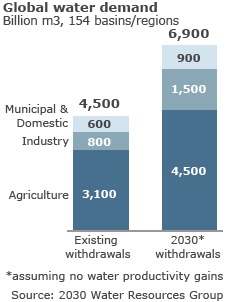Monday is World Water Day, but I suspect relatively few will have noticed.
“Global water
requirements … will be 40%
greater than what can currently
be sustainably supplied”
While the world is rightly moving to address the challenges presented by climate change and depleting supplies of fossil fuels, the same awareness and consensus does not exist when it comes to addressing our usage of water. Yet the harsh fact is that we will probably run out of water long before we run out of fuel.
We need to act fast, now.
Most people equate water consumption with what they use in their homes and places of work, but the challenge facing the globe goes much, much further than that. The 2030 Water Resources Group, a collaboration between the private and social sectors to discover solutions to combat water scarcity, estimates that global water requirements will grow by over 50% over the next 20 years. Such levels of usage will be 40% greater than what can currently be sustainably supplied.
Of course this global figure is an aggregation: at a more local level the situation is far worse. For example, by 2030 one third of the global population, mainly concentrated in developing countries, will have only half the amount of naturally renewed water available they need.
More than tap
Efficiency in water usage is not improving fast enough
What most consumers might not be aware of is that agriculture accounts for 70% of global water usage today, and how the need to feed the growing population of the world will put an even greater strain on already scarce water resources.
And in recent years food and water supplies have also been significantly affected by the use of agricultural land and resources on the production of biofuels.
The 2030 Water Resources Group also predicts that industrial use of water will almost double by 2030. It currently accounts for 16% of total usage – more than half of it for energy production – and this will grow to a projected 22% by 2030 with China alone accounting for 40% of the additional demand.
The challenge facing governments, businesses and – arguably – all of us, is how to close the gap in supply in a way that is both environmentally sustainable and economically viable. At the moment we are coping by ‘borrowing’ water supplies from non-replenishable aquifers or from water reserved for environmental needs, an approach which is clearly not a long-term solution.
Crop per drop
Efficiency lies at the heart of debate, just as with climate change. Yet while great strides have been made around carbon, the track record of water efficiency from both agriculture and industry does not inspire confidence: between 1990 and 2004 the annual rate of efficiency improvement in both sectors was approximately only 1%.
Agricultural productivity has the potential therefore to play a fundamental role and increasing the “crop per drop” is vital, particularly in the developing world.
There are measures such as no-till farming, improved drainage and utilisation of the best seeds that may even have a positive return for farmers. The water cost curve of the 2030 Water Resources Group shown in this document provides the tools for comprehensive, cost effective strategies.
Microfinance
Within an overall strategy, the buyers of the farmers’ produce can also play their part by offering their suppliers training, technical assistance and even microfinance to help them improve water efficiency. This is an approach we have taken at Nestle where, for example, we provide more than $30m worth of micro-credit loans yearly to more than 600,000 farmers worldwide.
Water shortages are more pressing than climate change
Just as microfinance can help farmers, policymakers, financiers and the private sector can do more to ensure that those willing to improve their water footprint at the macro level are given the opportunity – and capital – to do so.
Efficiency must also be a focus for industry and those responsible for planning and managing economic development. Companies and governments are often quick to trumpet their energy efficiency achievements, but too few have taken the same approach with water.
The sooner governments, industry and consumers start to see the links between energy, food and water security, and how policies in one area affect another, the more likely it is that water scarcity will get the profile it deserves and that we start acting decisively to assure the sustainability of humankind’s most precious resource, water.
By Peter Brabeck-Letmanthe
Chairman, Nestle





